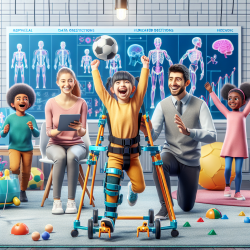Introduction
In the realm of pediatric therapy, innovation is key to unlocking new potentials for children with mobility impairments. A recent study titled "Physiotherapy-assisted overground exoskeleton use: mixed methods feasibility study protocol quantifying the user experience, as well as functional, neural, and muscular outcomes in children with mobility impairments" sheds light on a groundbreaking approach that could redefine therapeutic practices. This study focuses on the use of the Trexo Plus, a pediatric lower limb exoskeleton, designed to enhance mobility and functional outcomes in children with severe mobility challenges.
Key Findings and Implications
The study provides compelling evidence on several fronts:
- Feasibility and Safety: The research confirms the clinical feasibility, safety, and acceptability of using the Trexo in both school and outpatient settings. This is crucial for practitioners considering integrating such technology into their therapeutic repertoire.
- Functional and Neural Outcomes: Significant improvements were observed in motor and functional outcomes, alongside changes in brain structure and connectivity. This suggests that exoskeleton-assisted therapy may promote neuroplasticity, a vital component in pediatric rehabilitation.
- User Experience: The study highlights positive feedback from children, parents, and physiotherapists, indicating high levels of comfort and engagement. This underscores the importance of user-centered design in therapeutic devices.
Practical Applications for Practitioners
For practitioners, these findings offer a pathway to enhance therapeutic outcomes through data-driven decisions. Here are some practical applications:
- Incorporating Technology: Consider integrating exoskeletons like the Trexo into therapy sessions to provide children with novel opportunities for movement and engagement.
- Focus on Neuroplasticity: Design therapy sessions that capitalize on the potential for neuroplasticity, using repetitive, task-specific activities that the exoskeleton facilitates.
- User Feedback: Regularly gather feedback from children and their families to refine therapy approaches and ensure the technology meets their needs.
Encouragement for Further Research
While this study provides a solid foundation, it also highlights the need for further research. Practitioners are encouraged to explore additional studies to continue improving therapeutic practices. Investigating long-term outcomes and expanding the use of exoskeletons to other conditions could provide valuable insights.
To read the original research paper, please follow this link: Physiotherapy-assisted overground exoskeleton use: mixed methods feasibility study protocol quantifying the user experience, as well as functional, neural, and muscular outcomes in children with mobility impairments.










